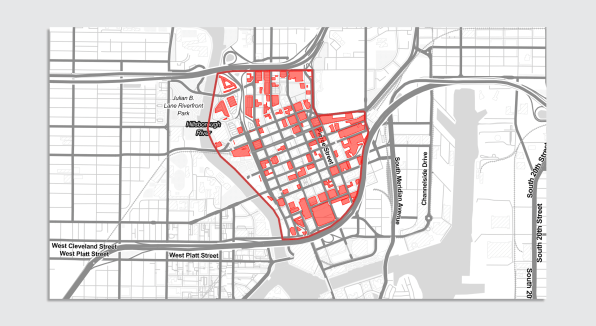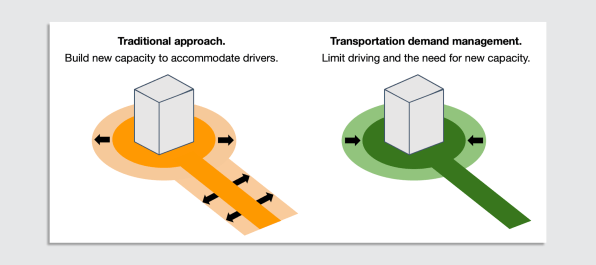- | 8:00 am
Traffic is ruining downtowns. Here’s how cities are getting rid of it
To get projects approved, cities are requiring developers to offer strategies for cutting car use.

The U.S. has a car-centric culture that is inseparable from the way its communities are built. One striking example is the presence of parking lots and garages. Across the country, parking takes up an estimated 30% of space in cities. Nationwide, there are eight parking spots for every car.
The dominance of parking has devastated once-vibrant downtowns by turning large areas into uninviting paved spaces that contribute to urban heating and stormwater runoff. It has driven up housing costs, since developers pass on the cost of providing parking to tenants and homebuyers. And it has perpetuated people’s reliance on driving by making walking, biking, and public transit far less attractive, even for the shortest trips.
Why, then, does the U.S. have so much of it?
For decades, cities have required developers to provide a set number of parking spaces for their tenants or customers. And while many people still rely on parking, the amount required is typically far more than most buildings need.
Columbus, Ohio, pioneered this strategy 100 years ago, and by the middle of the 20th century, minimum parking requirements were the norm nationwide. The thinking was straightforward: As driving became more common, buildings without enough parking would clog up the streets and wreak havoc on surrounding communities.
Today, however, more urban planners and policymakers acknowledge that this policy is narrowly focused and shortsighted. As a data scientist who studies urban transportation, I focused my earliest research on this topic, and it shaped how I think about cities and towns today.
It’s encouraging to see cities rethinking minimum parking requirements—but while this is an important reform, urban leaders can do even more to loosen parking’s grip on our downtowns.
ELIMINATING PARKING REQUIREMENTS
Despite research and guidance from the Institute of Transportation Engineers, it is extremely difficult to predict parking demand, especially in downtown areas. As a result, for years many cities set the highest possible targets. This led to excess parking that is vastly underused, even in areas with perceived shortages.
In 2017, Buffalo, New York, became the first large U.S. city to eliminate its minimum parking requirement as part of its first major overhaul of zoning laws in more than 60 years. This shift has breathed new life into downtown Buffalo by spurring redevelopment of vacant lots and storefronts. Researchers estimate that more than two-thirds of newly built homes there would have been illegal before the policy change because they would not have met the earlier standards.
In the same year, Hartford, Connecticut, followed Buffalo’s lead and eliminated mandatory parking minimums citywide. Communities including Minneapolis; Raleigh, North Carolina; and San Jose, California, have since taken similar steps.
Tony Jordan, president of the nonprofit Parking Reform Network, has argued that once cities stop mandating specific levels of private parking, leaders need to be more thoughtful about how they manage public curbside parking and spend the revenues that it generates. Some communities have implemented maximum parking allowances to ensure that developers and their investors don’t add to the glut.

REDUCING RELIANCE ON CARS
Parking mandates aren’t the only lever that city officials can use to make their downtowns less car-centric. Some local governments are now asking developers to help reduce overall traffic levels by investing in improvements like sidewalks, bike storage, and transit passes.
This approach is typically called transportation demand management, or modern mitigation. It still leverages private investment to serve the public good but without a singular focus on parking.
And unlike parking requirements, this strategy helps connect buildings to their surrounding communities. As urban planning scholar Kristina Currans explained to me in an interview, traditional parking requirements ask developers to fend for themselves. In contrast, transportation demand management policies require them to consider the surrounding context, integrate their projects into it, and help cities function more efficiently.

This approach dates back at least to 1998, when Cambridge, Massachusetts, introduced a policy requiring developers to produce a transportation demand management plan whenever they add new parking. That policy has now outlived the city’s minimum parking requirements, which Cambridge eliminated for all residential uses in 2022.
Newer policies tend to incorporate point systems or calculators that link different strategies directly to their potential impact on car use. These tools are common in cities across California, where state law now requires city planners to evaluate how much new car use each new development will generate and take steps to limit the impact. Policies such as charging users directly for parking spots or offering employees cash in exchange for giving up their spot are among the most effective.
LESSONS FROM MADISON
The University of Wisconsin-Madison’s State Smart Transportation Initiative, which I direct, along with UW’s Mayors Innovation Project, has outlined policies like these in a guide based on our earlier work with the city of Los Angeles. We recently collaborated on a new transportation demand management program in Madison.
This program initially faced some pushback from developers, but their input ultimately made it better. It passed the city’s Common Council unanimously in December 2022.
For their projects to be approved, developers now must earn a certain number of traffic mitigation points based on how large their project is and how many parking stalls they propose to include with it. For example, providing information to visitors and tenants about different travel options earns one point; providing secure bike storage earns two points; offering on-site child care earns four points; and charging market-rate parking fees is worth 10 points. Scaling back planned parking can reduce the number of points they need to earn in the first place.
While parking is no longer required in many parts of Madison, this new policy adds a layer of accountability to ensure that developers provide access to multiple transportation options in environmentally responsible ways. As urban leaders look for meaningful opportunities to reduce their cities’ contributions to climate change, we may soon see other cities following suit.
This article is republished from The Conversation under a Creative Commons license. Read the original article.





































